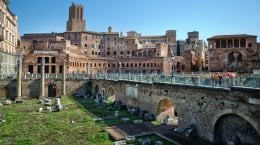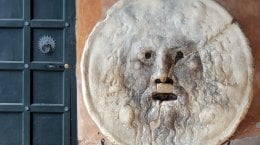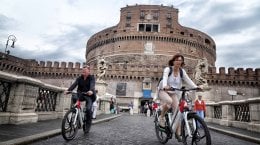Official Reseller Rome and Vatican – Jubilee 2025
St. Peter’s Basilica
The Basilica of St. Peter in the Vatican, in Rome, considered the symbol and center of Catholicism, is the largest of the four Roman basilicas, and is located near the Apostolic Palace.
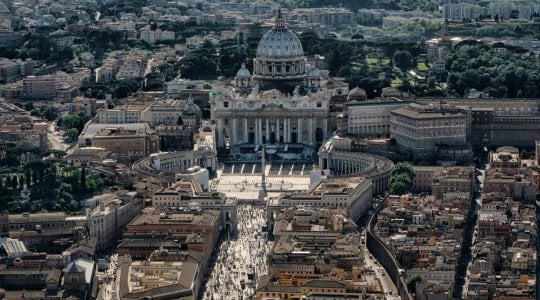
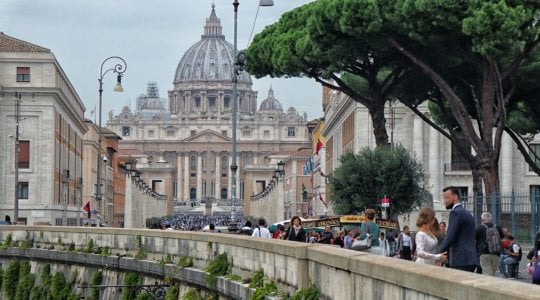
The Basilica of St. Peter in the Vatican, in Rome, considered the symbol and center of Catholicism, is the largest of the four Roman basilicas, and is located near the Apostolic Palace.
Its construction began on April 18, 1506, during the pontificate of Pope Julius II, and ended in 1626, with Pope Urban VIII. In the area occupied by the basilica, previously stood another church built by the Emperor Constantine, which dated back to the 4th century, and which was located on the area of Nero’s circus and an adjacent necropolis, where St. Peter was buried according to tradition.
This construction, unique for its imposing size, included five naves with wooden roofs, and had a plan similar to that of the Basilica of St. Paul Outside the Walls. During the pontificate of Pope Nicholas V, the building, which survived the fall of the Western Roman Empire, underwent major transformations by Bernardo Rossellino, who wanted to keep the longitudinal body with five naves, covering it with cross vaults, and widening the transept of the apse. The most characteristic innovation was the addition of a choir (the choir of Rossellino), which continued the nave.
Around 1450, the architect Bramante, began impressive renovations, which were subsequently suspended for several years. Bramante designed a large hemispherical dome, inspired by that of the Pantheon, supported by four pillars and placed in the center of the Greek-cross complex, (a great revolutionary idea). This project was linked to the studies undertaken by Leonardo da Vinci on the central plan churches.
After yet another suspension of the works, caused also by many controversies relating to the alleged gigantism of the basilica, the works resumed from 1514 under the guidance of Raffaello Sanzio and others, who made numerous modifications to the previous project, without completing the work. In 1546, Michelangelo Buonarroti, who was very old at that time, took over from his predecessors, with the intention of finishing the work. His idea was to eliminate the perfect symmetry desired by Bramante, with the prediction of a pronaos, to introduce into the design that typical strength and drama of his genius, in antithesis with the typical Renaissance balance. Michelangelo gave particular emphasis to the dome, which became the real fulcrum of his project, inspired by that of Filippo Brunelleschi for the cathedral of Santa Maria del Fiore in Florence.
After numerous hardships and after the alternation of many architects, the completion of the works for the basilica took place starting from 1603, and could also count on the contribution of Gian Lorenzo Bernini, who studied the problem of bell towers. St. Peter was finally consecrated on November 18, 1626 by Pope Urban VIII. The area in front of the basilica is called Piazza St. Peter, and has a characteristic structure and dimensions such as to contain a very large numbers of devotees.
St. Peter’s Basilica: description
The Basilica of St. Peter is one of the largest buildings in the world, with a length of 218 meters, and a height of 133 meters. Its surface reaches 23,000 square meters and has a capacity of 60,000 people. The whole building is entirely walkable, and it is connected to the Vatican Palaces through an elevated corridor, and to the sacristy through two elevated corridors. The external facade, 114 meters wide and 45 meters high, is covered with travertine, which gives the building an aspect of great charm and elegance; two statues, depicting St. Peter and St. Paul, precede it. The bell cell houses six bells.
The porch extends over the entire width of the facade and has five openings towards the basilica: these are the famous five doors, including the one designed by Giacomo Manzù in 1964.
The aisles contain 45 altars and 11 chapels, rich in numerous works of art; the central one appears as the largest and most imposing, 90 meters long, and covered by the colossal Baldacchino of St. Peter. In the right aisle there is the famous Pietà by Michelangelo, one of the main attractions of this basilica.
From 07:00 a.m. to 6:00 p.m. every day (until 7:00 p.m. during winter), except Wednesday (if there is a papal audience, the Basilica will be closed until 12:00 p.m.).
Admission is free You can also visit the dome (from October to March every day from 08:00 a.m. to 4:45 p.m., until 5:45 p.m. from April to September);
Admission is charged.
The Basilica of St. Peter in the Vatican, is located in the very center of Rome, therefore it is absolutely advisable to use public transport to reach it, as they can access the lanes and preferential routes, differently from private cars. Depending on your location, you can use various solutions, namely:
– from Fiumicino Airport, you can use a shuttle train (Leonardo Express) which stops at Roma Termini Station, the starting point to access the city center, in about thirty minutes.
– from Ciampino Airport, you can take a panoramic shuttle bus (Terravision), which arrives at Rome Termini Station in forty minutes, depending on traffic.
– from Roma Termini Station, you can get the bus n.64, with a journey of about twenty minutes; or you can use the Metro (Red Line)
– from Roma Termini Station a public car service is also available, but the cost of this service is considerably higher than the previous proposals.
Being located practically in the heart of the capital, the Basilica of St. Peter is an excellent starting point for visiting many works of art, in addition to the Vatican Museums and Castel Sant’Angelo. We highlight in particular:
– Ponte Sant’Angelo, which is considered one of the most beautiful and ancient of Rome, enriched by many statues of angels and saints, made by famous sculptors, such as Lorenzo Bernini, Paul Romano and Lorenzetto.
– Sanctuary of the Divine Misericordia, also known as the Church of Santo Spirito in Sassia as commissioned by the King of the Saxons, which houses ancient frescoes.
– Borgo Sant’Angelo, which expands along the Vatican walls, and which has maintained an unchanged and particularly evocative appearance over time.
– Leonardo da Vinci permanent museum, which offers a very special multimedia experience related to the works of the great artist.
– St. Giovanni dei Fiorentini museum of sacred art, which exhibits sculptures, paintings and liturgical objects, including works by Bernini and Cellini.
– Napoleonic museum, which preserves relics and works of art related to the figure of Napoleon, divided into three sections in a temporal sequence.


